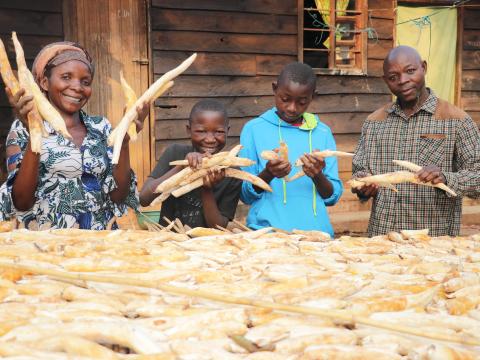Reliable access to land for the most vulnerable for increased food production in Kalehe hills of East DRC

By Jean-Baptiste Mirindi, World Vision SBCC Senior officer
Zawadi BIMERA is now optimistic about a better future for her children because she sees a high crop yield from her field. This, she says "is a solution to improved nutrition of both her family and village -Tchibanga."
"I had lost all hope. It was a miserable life for our 7-children because they did not have enough to eat. It was even more disappointing that after hiring land for $100, and planting our usual variety of cassava cuttings, we had pitiful yields. The story is similar for most of my friends. To find a piece of land to cultivate, one has to pay money and commit to working on the hill owner’s land two days a week,” Zawadi recalls.
This practice called Salongo is often a source of community conflict. If the tenant is unable to fulfill the stipulated obligations the landowner rents the parcel of land to another person, which leads to tensions. The challenge with the land tenure system in Kalehe has failed families to produce food and subsequently led to sustained cases of malnutrition and stunting.
"As a farmer, my only source of income is the field, but the lack of agricultural land coupled with low agricultural productivity was slowly killing my dream. When World Vision taught us about energy-giving food, body-building food, protective food, and the snack for pregnant and breastfeeding women, I felt this was an impossible task since I lacked resources to make it happen," Zawadi says. "From my field of 50m by 50m I could only harvest 150 kg of cassava," she adds.
Thankfully, in 2018 the Food Security Project (FSP) ENYANYA, funded by USAID launched its green hill development activities in Kalehe. Zawadi joined the green hill committee called Abalinyuma bajembere, meaning "those who are behind should go ahead." Her group selected her to be the cashier.
The FSP facilitated the dialogue between landowners and the land tenants, allowing access to land for the most vulnerable who could otherwise not have gotten land, leaving no one behind. It took several meetings facilitated by World Vision and convened by the village chiefs, traditional leaders, and the territorial inspector for Agriculture. Landowners agreed to reduce land rental fees to $40 for a year, instead of $100.
Another deal was that vulnerable farmers get free land but share farm produce with the landowner. “The landowner cedes the parcels of land to cultivate and buys the seed for the farmer, in return they divide the production into two equal parts” Zawadi explains. This is how Zawadi got another field, which she is currently cultivating. Like her neighbors, she learned how to fertilize the soil as well as safeguard her farm from soil erosion.
Every land commitment is concluded by a rental contract between the land tenant and the landowner. This has reduced land conflicts, and working together to manage the hill, has contributed to community cohesion.
"I got a field of 50m out of 50 in the Anastase hill, and at the first production, I had 600kg of cassava pods because I had planted the V8 improved variety of cuttings. It was the first time that I had so many kgs of cassava stored in my house to feed my children with some left for sale," she relates.
To ensure no one is left behind, World Vision deploys several approaches in East DRC, in particular the development of green hills. 685 farmers grouped in 6 hills are supported by the project. In total, 2,740 children benefit from the activities on the different hills. "The health of our children has improved, and they can now smile in the morning, during the day, and in the evening because they have enough food to eat.," Zawadi says.
World Vision implements the FSP in a consortium led by Mercy Corps. The project is in its seventh and final year of implementation.